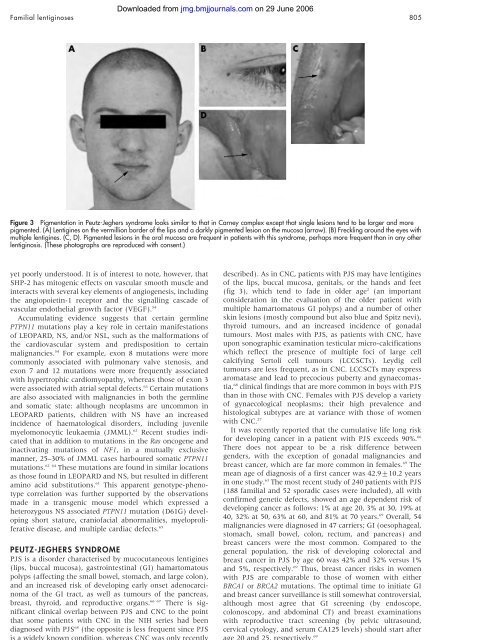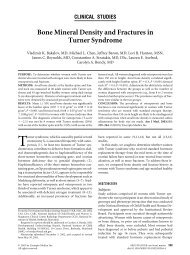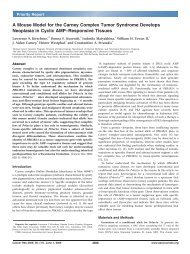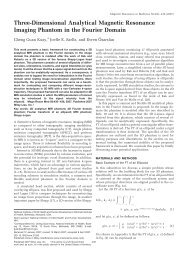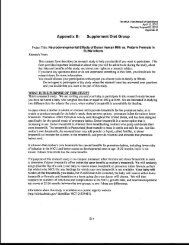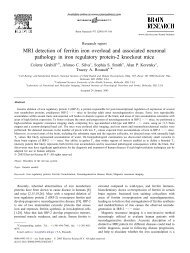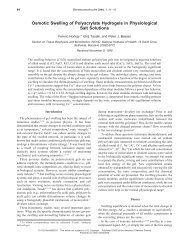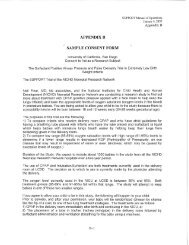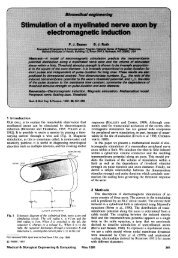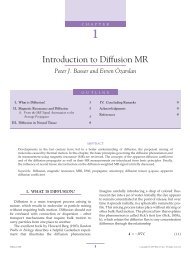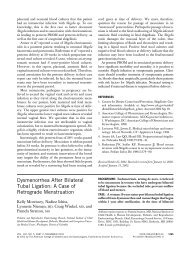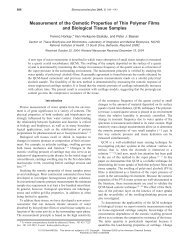The lentiginoses: cutaneous markers of systemic disease and a ...
The lentiginoses: cutaneous markers of systemic disease and a ...
The lentiginoses: cutaneous markers of systemic disease and a ...
You also want an ePaper? Increase the reach of your titles
YUMPU automatically turns print PDFs into web optimized ePapers that Google loves.
Familial <strong>lentiginoses</strong><br />
Downloaded from jmg.bmjjournals.com on 29 June 2006<br />
805<br />
Figure 3 Pigmentation in Peutz-Jeghers syndrome looks similar to that in Carney complex except that single lesions tend to be larger <strong>and</strong> more<br />
pigmented. (A) Lentigines on the vermillion border <strong>of</strong> the lips <strong>and</strong> a darkly pigmented lesion on the mucosa (arrow). (B) Freckling around the eyes with<br />
multiple lentigines. (C, D). Pigmented lesions in the oral mucosa are frequent in patients with this syndrome, perhaps more frequent than in any other<br />
lentiginosis. (<strong>The</strong>se photographs are reproduced with consent.)<br />
yet poorly understood. It is <strong>of</strong> interest to note, however, that<br />
SHP-2 has mitogenic effects on vascular smooth muscle <strong>and</strong><br />
interacts with several key elements <strong>of</strong> angiogenesis, including<br />
the angiopoietin-1 receptor <strong>and</strong> the signalling cascade <strong>of</strong><br />
vascular endothelial growth factor (VEGF). 54<br />
Accumulating evidence suggests that certain germline<br />
PTPN11 mutations play a key role in certain manifestations<br />
<strong>of</strong> LEOPARD, NS, <strong>and</strong>/or NSL, such as the malformations <strong>of</strong><br />
the cardiovascular system <strong>and</strong> predisposition to certain<br />
malignancies. 54 For example, exon 8 mutations were more<br />
commonly associated with pulmonary valve stenosis, <strong>and</strong><br />
exon 7 <strong>and</strong> 12 mutations were more frequently associated<br />
with hypertrophic cardiomyopathy, whereas those <strong>of</strong> exon 3<br />
were associated with atrial septal defects. 63 Certain mutations<br />
are also associated with malignancies in both the germline<br />
<strong>and</strong> somatic state: although neoplasms are uncommon in<br />
LEOPARD patients, children with NS have an increased<br />
incidence <strong>of</strong> haematological disorders, including juvenile<br />
myelomonocytic leukaemia (JMML). 62 Recent studies indicated<br />
that in addition to mutations in the Ras oncogene <strong>and</strong><br />
inactivating mutations <strong>of</strong> NF1, in a mutually exclusive<br />
manner, 25–30% <strong>of</strong> JMML cases harboured somatic PTPN11<br />
mutations. 62 64 <strong>The</strong>se mutations are found in similar locations<br />
as those found in LEOPARD <strong>and</strong> NS, but resulted in different<br />
amino acid substitutions. 61 This apparent genotype-phenotype<br />
correlation was further supported by the observations<br />
made in a transgenic mouse model which expressed a<br />
heterozygous NS associated PTPN11 mutation (D61G) developing<br />
short stature, crani<strong>of</strong>acial abnormalities, myeloproliferative<br />
<strong>disease</strong>, <strong>and</strong> multiple cardiac defects. 65<br />
PEUTZ-JEGHERS SYNDROME<br />
PJS is a disorder characterised by muco<strong>cutaneous</strong> lentigines<br />
(lips, buccal mucosa), gastrointestinal (GI) hamartomatous<br />
polyps (affecting the small bowel, stomach, <strong>and</strong> large colon),<br />
<strong>and</strong> an increased risk <strong>of</strong> developing early onset adenocarcinoma<br />
<strong>of</strong> the GI tract, as well as tumours <strong>of</strong> the pancreas,<br />
breast, thyroid, <strong>and</strong> reproductive organs. 66 67 <strong>The</strong>re is significant<br />
clinical overlap between PJS <strong>and</strong> CNC to the point<br />
that some patients with CNC in the NIH series had been<br />
diagnosed with PJS 68 (the opposite is less frequent since PJS<br />
is a widely known condition, whereas CNC was only recently<br />
described). As in CNC, patients with PJS may have lentigines<br />
<strong>of</strong> the lips, buccal mucosa, genitals, or the h<strong>and</strong>s <strong>and</strong> feet<br />
(fig 3), which tend to fade in older age 2 (an important<br />
consideration in the evaluation <strong>of</strong> the older patient with<br />
multiple hamartomatous GI polyps) <strong>and</strong> a number <strong>of</strong> other<br />
skin lesions (mostly compound but also blue <strong>and</strong> Spitz nevi),<br />
thyroid tumours, <strong>and</strong> an increased incidence <strong>of</strong> gonadal<br />
tumours. Most males with PJS, as patients with CNC, have<br />
upon sonographic examination testicular micro-calcifications<br />
which reflect the presence <strong>of</strong> multiple foci <strong>of</strong> large cell<br />
calcifying Sertoli cell tumours (LCCSCTs). Leydig cell<br />
tumours are less frequent, as in CNC. LCCSCTs may express<br />
aromatase <strong>and</strong> lead to precocious puberty <strong>and</strong> gynaecomastia,<br />
68 clinical findings that are more common in boys with PJS<br />
than in those with CNC. Females with PJS develop a variety<br />
<strong>of</strong> gynaecological neoplasms; their high prevalence <strong>and</strong><br />
histological subtypes are at variance with those <strong>of</strong> women<br />
with CNC. 27<br />
It was recently reported that the cumulative life long risk<br />
for developing cancer in a patient with PJS exceeds 90%. 66<br />
<strong>The</strong>re does not appear to be a risk difference between<br />
genders, with the exception <strong>of</strong> gonadal malignancies <strong>and</strong><br />
breast cancer, which are far more common in females. 69 <strong>The</strong><br />
mean age <strong>of</strong> diagnosis <strong>of</strong> a first cancer was 42.9¡10.2 years<br />
in one study. 63 <strong>The</strong> most recent study <strong>of</strong> 240 patients with PJS<br />
(188 familial <strong>and</strong> 52 sporadic cases were included), all with<br />
confirmed genetic defects, showed an age dependent risk <strong>of</strong><br />
developing cancer as follows: 1% at age 20, 3% at 30, 19% at<br />
40, 32% at 50, 63% at 60, <strong>and</strong> 81% at 70 years. 69 Overall, 54<br />
malignancies were diagnosed in 47 carriers; GI (oesophageal,<br />
stomach, small bowel, colon, rectum, <strong>and</strong> pancreas) <strong>and</strong><br />
breast cancers were the most common. Compared to the<br />
general population, the risk <strong>of</strong> developing colorectal <strong>and</strong><br />
breast cancer in PJS by age 60 was 42% <strong>and</strong> 32% versus 1%<br />
<strong>and</strong> 5%, respectively. 69 Thus, breast cancer risks in women<br />
with PJS are comparable to those <strong>of</strong> women with either<br />
BRCA1 or BRCA2 mutations. <strong>The</strong> optimal time to initiate GI<br />
<strong>and</strong> breast cancer surveillance is still somewhat controversial,<br />
although most agree that GI screening (by endoscope,<br />
colonoscopy, <strong>and</strong> abdominal CT) <strong>and</strong> breast examinations<br />
with reproductive tract screening (by pelvic ultrasound,<br />
cervical cytology, <strong>and</strong> serum CA125 levels) should start after<br />
age 20 <strong>and</strong> 25, respectively. 69<br />
www.jmedgenet.com


